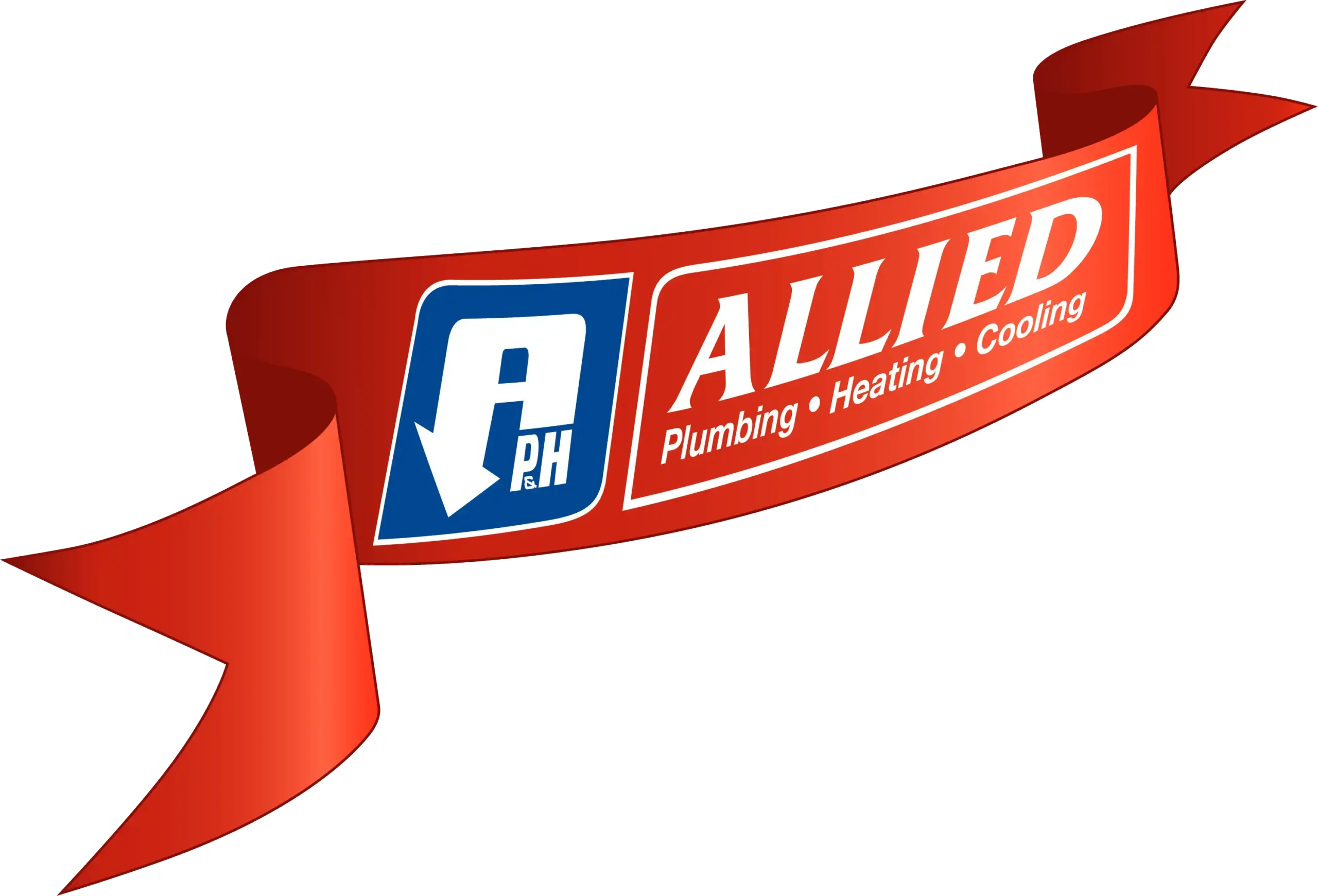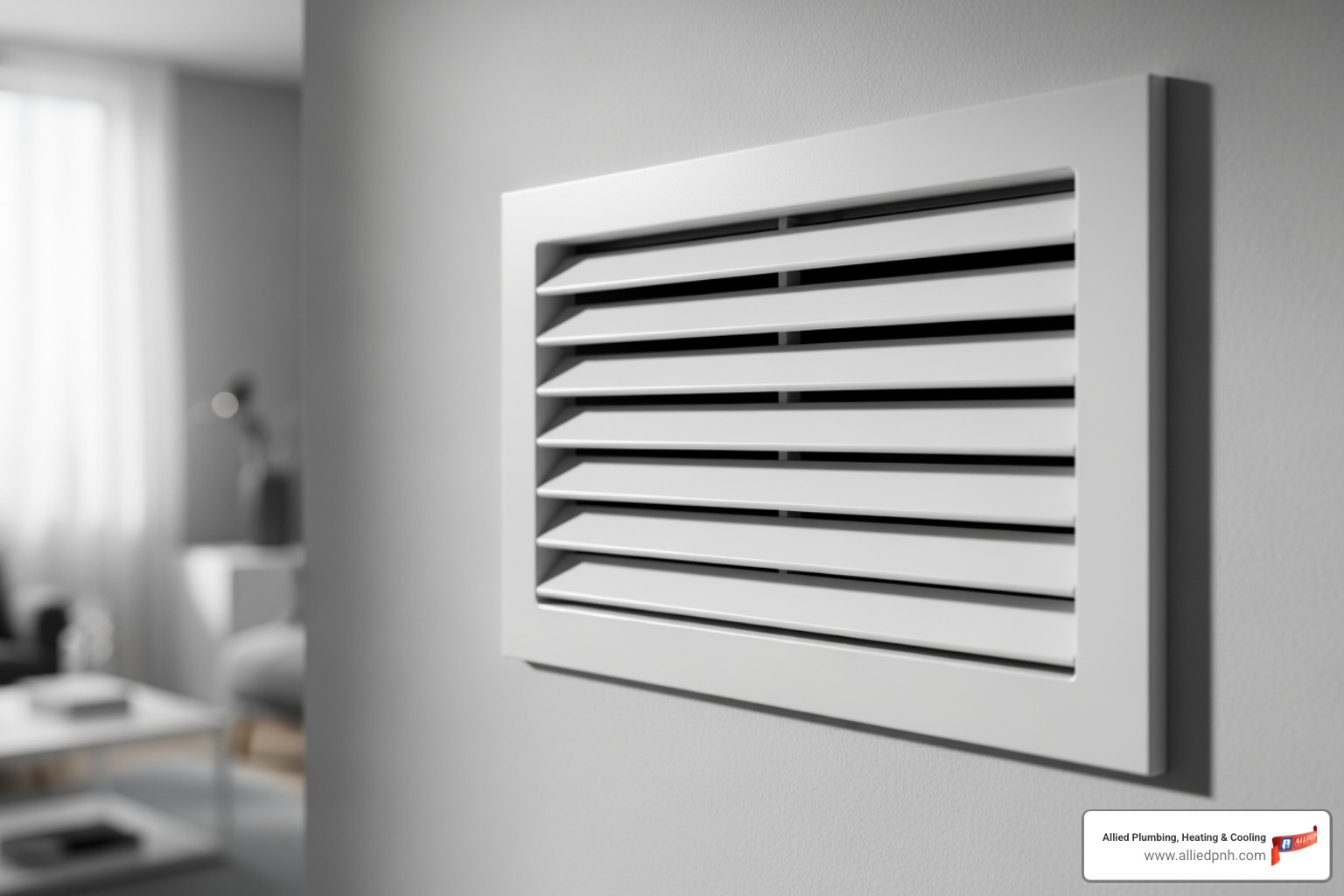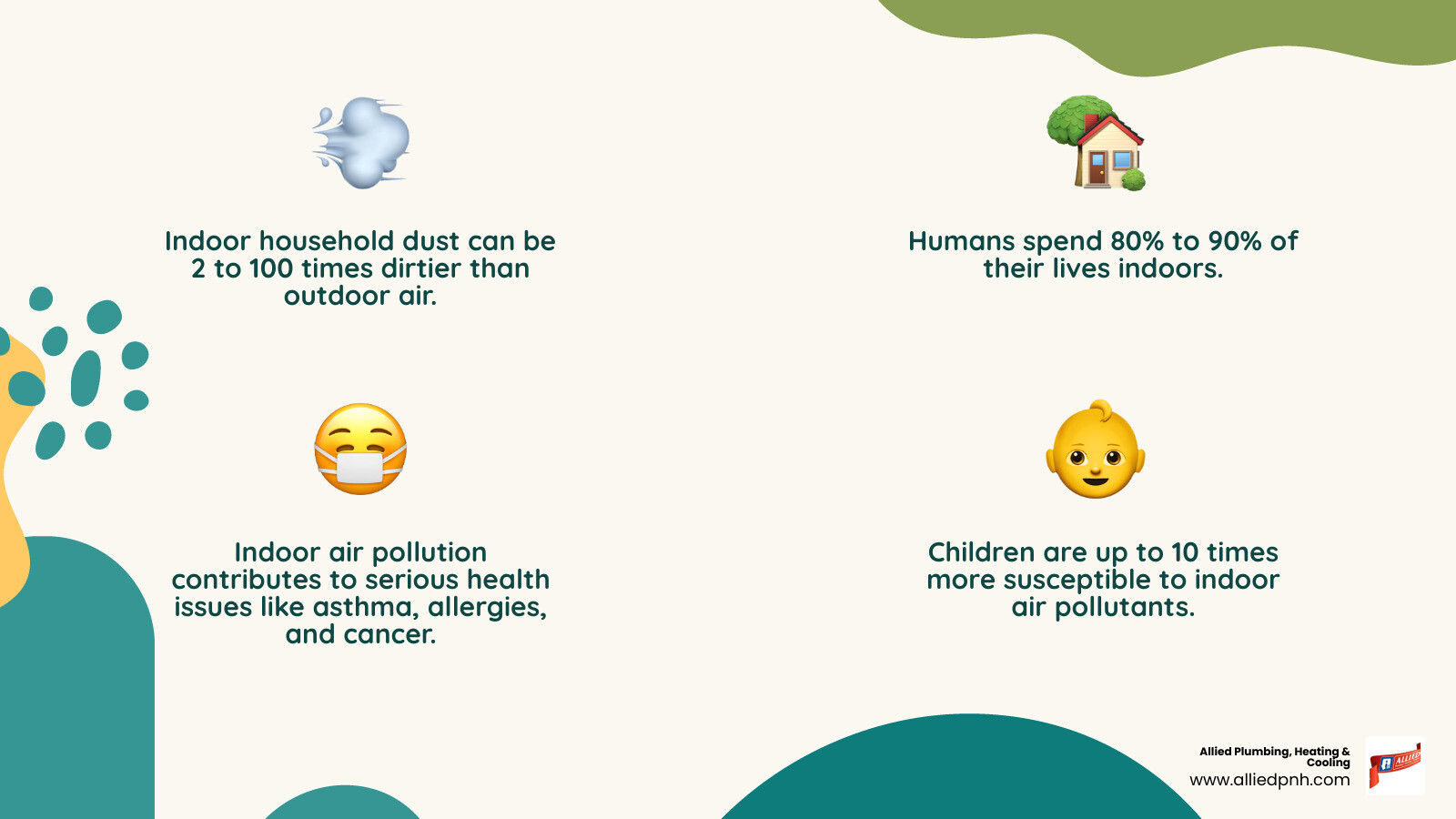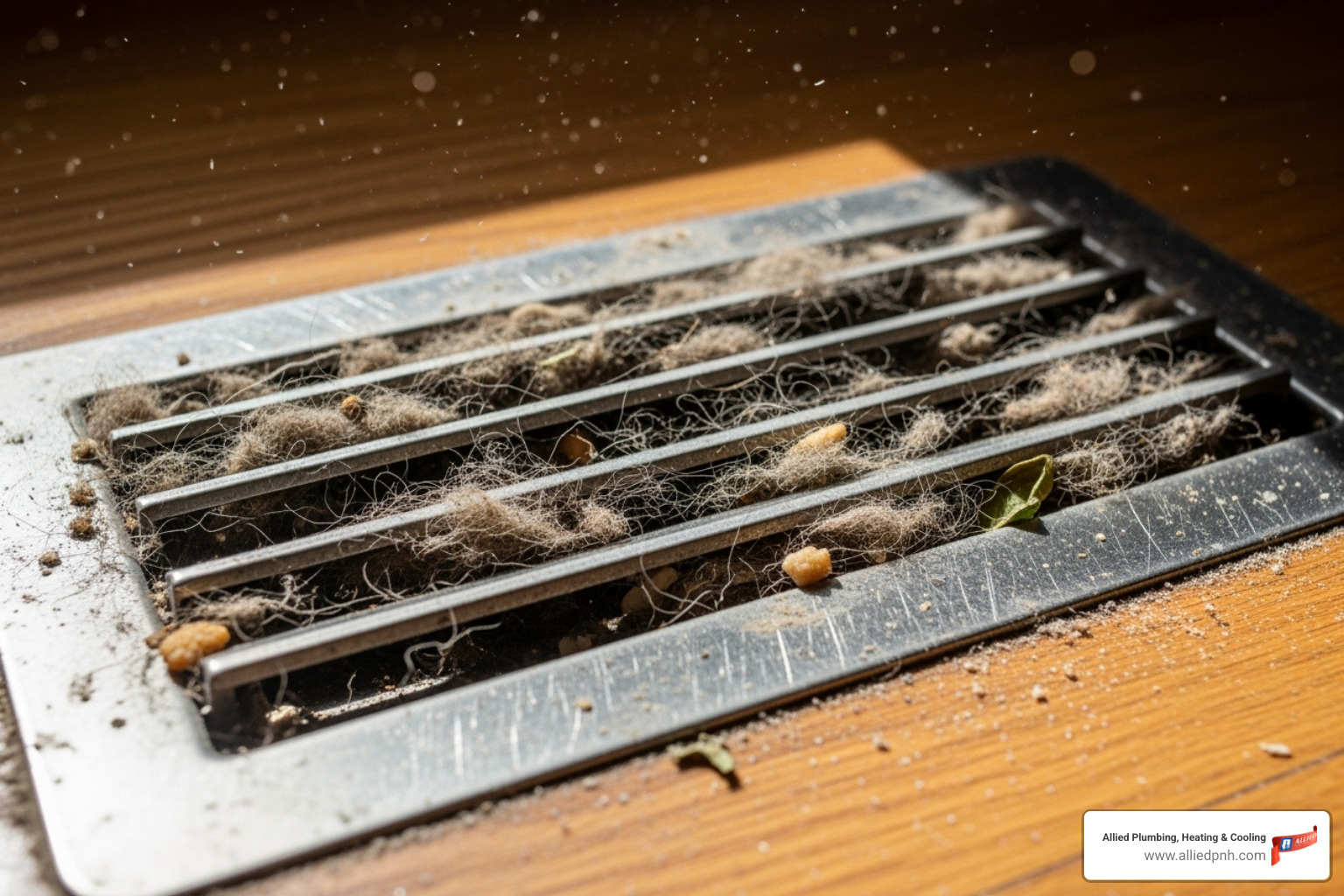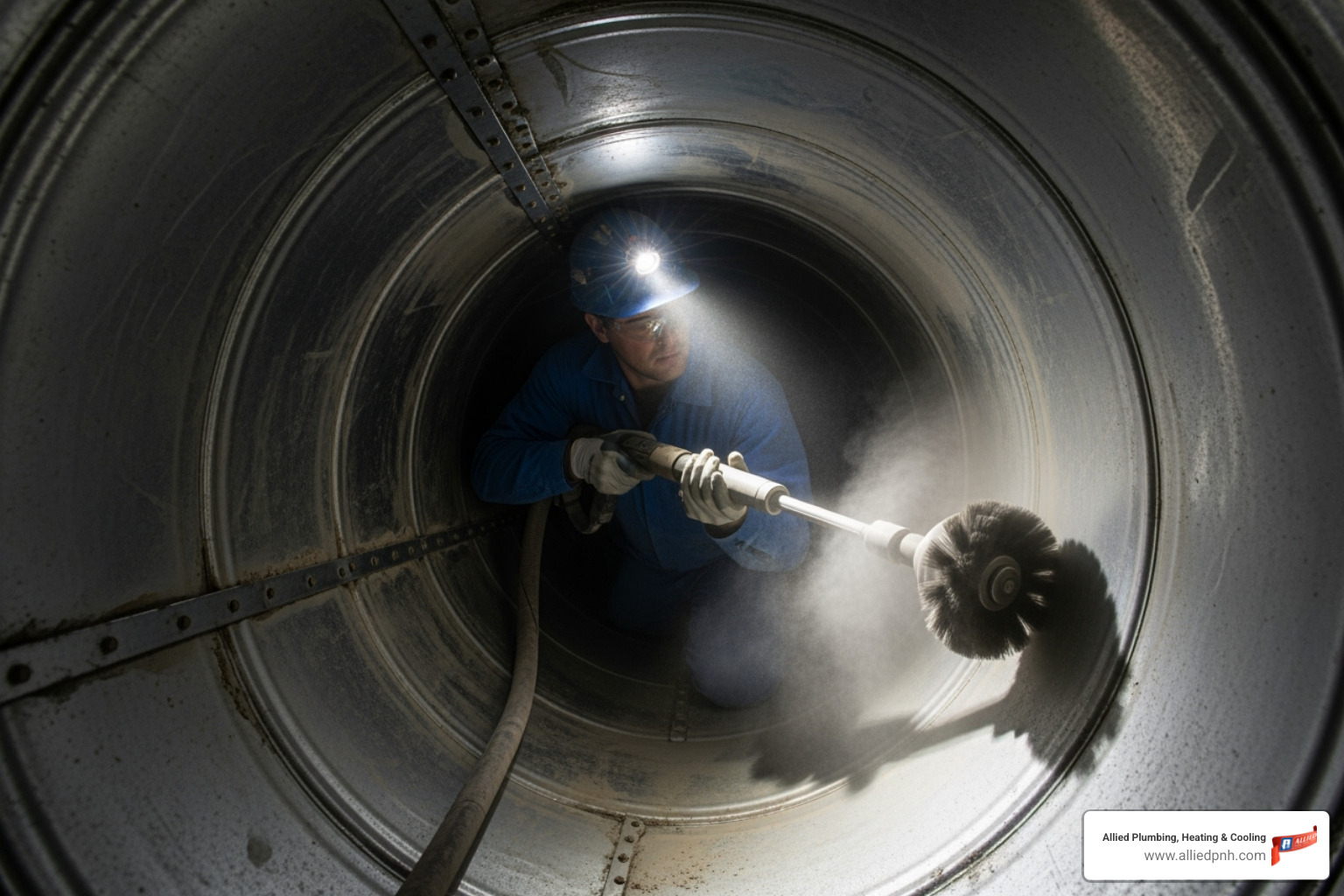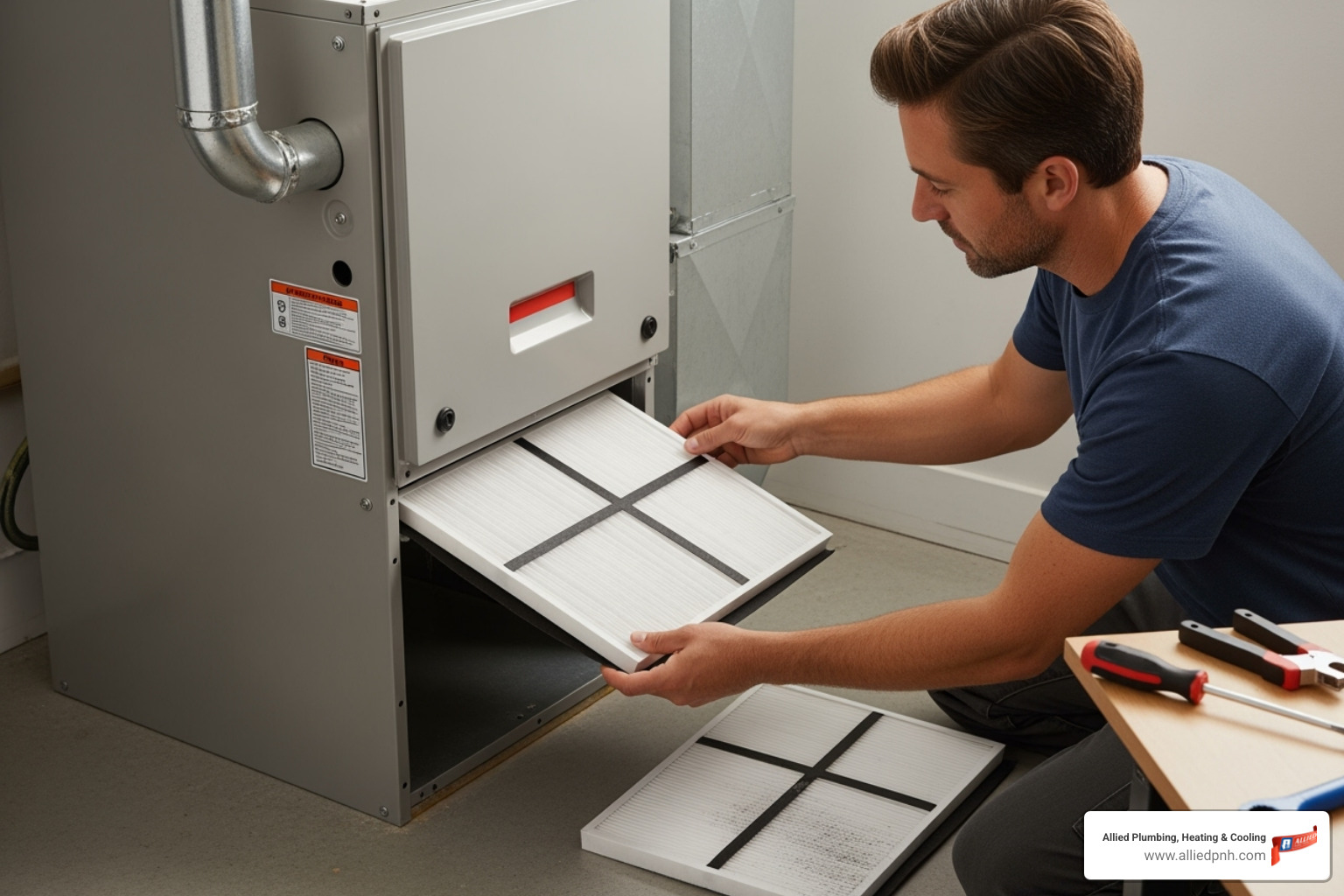Why Your Home’s Air Quality Depends on Clean Ducts
Air duct cleaning is the thorough removal of dust, debris, and contaminants from your home’s heating and cooling system. This includes the supply and return ducts, registers, grilles, and other HVAC components.
Key benefits of air duct cleaning include:
- Improved indoor air quality by removing accumulated dust, pollen, and allergens
- Better HVAC system efficiency through cleaner components and unrestricted airflow
- Reduced household dust that settles on furniture and surfaces
- Elimination of musty odors caused by mold, mildew, or pest debris
- Potential relief for allergy and asthma sufferers by reducing airborne irritants
Since most people spend up to 90% of their time indoors, the quality of your home’s air is crucial for your family’s health. Your HVAC system acts as your home’s respiratory system, circulating air through every room multiple times a day.
Over time, dust, pet dander, pollen, and other contaminants accumulate in your ductwork. While a light amount of dust is normal, certain situations—like substantial mold growth, pest infestations, or excessive debris blocking airflow—warrant professional cleaning.
The EPA notes that knowledge about air duct cleaning is still in its early stages and doesn’t recommend it for all homes. However, cleaning can be beneficial when specific problems exist or after events like major renovations that introduce significant dust into your system.
Why Consider Air Duct Cleaning? The Health and Home Benefits
The air inside your home can be 2 to 5 times more polluted than outdoor air. Since we spend about 90% of our time indoors, this is a significant health consideration. When dust, pollen, and other contaminants build up in your air ducts, they get circulated throughout your home every time your heating or cooling system runs. This can contribute to allergy symptoms, asthma flare-ups, and excessive household dust.
While the EPA notes that air duct cleaning hasn’t been proven to prevent health problems, removing accumulated irritants can make a noticeable difference for many families, especially those with children or members who suffer from allergies or asthma.
Here are the main benefits of air duct cleaning:
- Cleaner Air: By removing built-up dust, pollen, and pet dander, you eliminate a major source of airborne irritants, providing relief for family members with respiratory issues.
- Less Dust: A very noticeable benefit is less household dust. After a thorough cleaning, many homeowners find their surfaces stay clean much longer.
- Odor Removal: Duct cleaning can eliminate musty odors from mold, mildew, or pest debris, leaving your home smelling fresh.
- Improved HVAC Efficiency: When ducts and other system components are clogged, your system works harder. Cleaning the entire system can improve HVAC efficiency and help it last longer.
Showing the Signs: When to Clean Your Air Ducts
Your home will often signal when your air ducts need attention:
- Visible dust from vents: If you see dust blowing from your registers or a heavy buildup around vent covers, it’s a clear sign.
- Substantial mold growth: If you see or smell mold, cleaning is essential. You must also fix the underlying moisture problem.
- Pest or rodent infestation: Droppings and nesting materials from pests should be removed immediately to prevent them from circulating in your air.
- Post-renovation cleanup: If you didn’t seal your vents during a major renovation, a cleaning is needed to remove construction debris from your system.
- Unexplained allergy symptoms: If allergy or asthma symptoms worsen at home but improve elsewhere, contaminated ductwork could be a contributing factor.
How Often Should You Schedule an Air Duct Cleaning?
Most homes benefit from air duct cleaning every 3 to 7 years, but your needs may vary.
Consider more frequent cleaning (every 2-3 years) if you have pets that shed or smokers in the home. You should also schedule a cleaning after recent renovations or water damage to address debris or prevent mold growth.
If family members have severe allergies or asthma, a proactive approach with cleaning every 3-5 years can be beneficial. Regular maintenance helps spot when cleaning is needed. Our HVAC Maintenance Plan is designed to keep your system running at peak performance.
The Professional Air Duct Cleaning Process: What to Expect
Professional air duct cleaning uses the source removal method, the industry gold standard for effective cleaning. This process involves agitating contaminants within your ductwork and immediately drawing them out with a powerful vacuum.
Here’s what to expect from our technicians:
-
System Inspection: We begin with a thorough inspection of your supply and return air ducts, registers, and other components to assess contamination levels and identify issues like mold or pests.
-
Creating Negative Pressure: We connect powerful vacuum equipment to your ductwork, which prevents dust and debris from escaping into your home during the cleaning process.
-
Agitation and Cleaning: We use specialized agitation tools like high-speed brushes and air whips to scrub the inside of the ducts, dislodging stubborn dirt and debris. All loosened contaminants are immediately pulled into our vacuum system.
-
Component Cleaning: A comprehensive cleaning isn’t just for ducts. We also clean your registers and grilles, blower motor and housing, evaporator coil, and condensate drain pan. A dirty drain pan can cause water leaks and mold; learn more about Fixing Water Leaks Around Your AC Indoor Unit.
-
Final Inspection: We conduct a post-cleaning inspection to ensure the job meets our high standards, sometimes using cameras to show you the before-and-after results.
Common Equipment and Techniques
Professional cleaning relies on specialized equipment to ensure a thorough job.
- High-Powered Vacuums: These are essential for creating the negative pressure that captures all debris. Portable units used inside a home must have HEPA filtration to trap microscopic particles.
- Agitation Tools: These devices work with the vacuum to dislodge stuck-on debris. They include rotary brushes that scrub duct interiors, air whips that blast compressed air to knock debris loose, and skipper balls that propel themselves through ducts to dislodge contaminants.
The combination of powerful suction and effective agitation is what guarantees a truly clean system.
Truck-Mounted vs. Portable Vacuums
Both truck-mounted and portable systems can perform an excellent cleaning, but they have different strengths.
| Feature | Truck-Mounted Vacuum Systems | Portable Vacuum Systems |
|---|---|---|
| Power | Generally more powerful, with higher suction (up to 16,000 CFM) | Powerful, but typically less than truck-mounted units |
| Accessibility | Requires long hoses, which may limit reach in some buildings | More flexible for multi-story homes or tight spaces |
| Noise Level | Main unit is outside, keeping noise away from living areas | Operates inside the home, so it can be noisy |
| Debris Containment | Debris goes directly into the truck outside | Debris collects in sealed units inside the home |
| Effectiveness | Both can achieve NADCA standards with proper techniques | Both can achieve NADCA standards with proper techniques |
NADCA (the National Air Duct Cleaners Association) confirms that the technician’s skill and proper use of agitation tools are more important than the type of vacuum. At Allied, we use the right professional-grade equipment for your home’s specific needs to ensure a thorough clean.
How to Choose a Reputable Air Duct Cleaning Service
Finding a trustworthy air duct cleaning service is crucial to avoid scams. Beware of “blow-and-go” companies that offer “whole house specials” for an impossibly low price. Quality cleaning requires specialized equipment, trained technicians, and time, so these offers often result in poor work or hidden fees.
To find a professional, follow these tips:
- Get Written Estimates: A reputable company will provide upfront pricing that details the scope of work and methods used.
- Verify License and Insurance: This protects you in case of accidental damage during the cleaning process.
- Check References and Reviews: Look for companies with a long history of satisfied customers, like Allied Plumbing, Heating & Cooling, which has served the Springfield area since 1977.
- Be Wary of Health Claims: Be skeptical of companies making dramatic health claims or claiming to be “EPA certified,” as the EPA does not certify cleaning companies.
- Insist on Inspections: A quality company should offer pre-cleaning inspections to justify the service and post-cleaning inspections (often with photos) to show you the results.
For a list of certified professionals, use the NADCA professional duct cleaner search tool.
The Importance of NADCA Certification
NADCA, the National Air Duct Cleaners Association, is the global standard-setter for HVAC system cleaning. Choosing a NADCA-certified company ensures you’re getting a professional who adheres to a higher standard.
NADCA members follow a strict Code of Ethics and the NADCA Standard for cleaning. Every member company must have at least one certified Air Systems Cleaning Specialist (ASCS) on staff. ASCS certification is an internationally recognized credential that requires passing a rigorous exam and committing to ongoing education on the latest techniques and safety protocols.
By choosing a NADCA-certified professional, you are selecting a company committed to integrity, honesty, and excellence. You can learn more at the National Air Duct Cleaners Association (NADCA) website.
A Note on Chemical Biocides and Sealants
Some companies may offer to apply chemical biocides or sealants inside your ducts. It’s important to proceed with caution.
-
Chemical Biocides: The EPA has reservations about the routine use of these chemicals, which are designed to kill microorganisms. Their effectiveness inside ducts is not well-proven, and they can cause adverse health reactions. Any biocide must be EPA-registered for use in HVAC systems, and the label directions must be followed precisely.
-
Sealants: These products claim to encapsulate debris or seal leaks, but their long-term effectiveness and health effects are largely unknown. They can also affect the fire-retardant properties of some ducts and may void your HVAC system’s warranty.
Both the EPA and NADCA do not recommend the routine application of biocides or sealants. They should only be considered in specific situations, such as repairing fire-damaged ducts, after a thorough mechanical cleaning has been completed. At Allied, we prioritize thorough physical cleaning and use chemical treatments only when absolutely necessary, with full transparency.
If you’re hearing other strange noises, our guide on Why is Your AC Making a Buzzing Sound? might be helpful.
Proactive Measures: Preventing Duct Contamination
Preventing duct contamination is the best way to maintain good indoor air quality. A few proactive steps can keep your ducts cleaner for longer.
-
Change Filters Regularly: Your HVAC filter is your first line of defense. Use a high-efficiency filter with a MERV rating recommended for your system. Change it every 1-3 months—more often if you have pets or allergies. A clogged filter restricts airflow and reduces efficiency.
-
Seal Ducts During Renovations: Before starting a dusty home project, cover your supply and return vents with plastic sheeting and turn off the HVAC system. This simple step prevents construction debris from entering your ductwork.
-
Control Moisture: Moisture invites mold and bacteria. Promptly fix any water leaks near your HVAC system and ensure your AC’s condensate drain pan is clean and draining properly.
-
Maintain General Cleanliness: Regular vacuuming and dusting reduce the amount of dust and debris available to be pulled into your system.
-
Schedule Regular HVAC Maintenance: An annual professional tune-up is like a physical for your heating and cooling system. A technician can clean critical components and spot potential issues before they become major problems. We’ve been helping Springfield families with this since 1977.
These steps work together to keep your air clean and your system running efficiently. If you’re having efficiency issues, our guide on Why AC is Running But Not Cooling Your Home offers more insights.
Frequently Asked Questions about Air Duct Cleaning
Here are answers to the most common questions we hear from homeowners about air duct cleaning.
What is the typical cost for air duct cleaning?
Professional air duct cleaning is an intensive service. Beware of offers under a few hundred dollars, as they often indicate a scam or low-quality work. Based on industry standards, expect to invest $450 to $1,000 for a thorough cleaning.
Key factors that influence the price include:
- Home size and the length of the ductwork
- System accessibility (e.g., ducts in tight crawl spaces)
- The level of contamination (e.g., mold or post-renovation debris)
We provide transparent, written estimates before any work begins, so you know exactly what to expect.
Will cleaning my air ducts lower my energy bills?
The honest answer is: it can help, but it’s complicated. While air duct cleaning isn’t primarily an energy-saving service, it can contribute to better efficiency. Removing debris allows air to flow more freely, reducing strain on your system.
The greatest efficiency gains come from a comprehensive cleaning that includes not just the ducts, but also key components like the blower motor and evaporator coil. A clean, well-maintained system runs more efficiently and has a longer system lifespan, which can save you money on repairs and premature replacement over time.
For major efficiency problems, it may be time to explore if AC replacement with experts is a better long-term solution.
Can I clean my air ducts myself?
We strongly advise against DIY air duct cleaning. This is a job best left to professionals for several important reasons:
- DIY Limitations: Household vacuums lack the power to create the negative pressure required for effective source removal.
- Risk of Damage: You can easily tear or damage delicate ductwork, especially flexible or fiberglass-lined ducts, leading to costly repairs.
- Worsening Air Quality: Without proper technique, you are more likely to dislodge dust and contaminants and release them into your home’s air, making the problem worse.
Professionals have the specialized equipment, training, and experience to do the job safely and effectively, ensuring contaminants are fully removed from your home.
Conclusion
Your home’s air quality is a key part of a healthy living environment. Air duct cleaning is a valuable service that can make a real difference, from reducing household dust to providing relief for family members with allergies or asthma.
The key takeaway is that air duct cleaning is not needed on a rigid schedule, but it becomes a smart investment when you see signs of contamination like visible mold, pests, or excessive dust after renovations. A professional cleaning, combined with proactive maintenance like regular filter changes, helps your family breathe easier, keeps your home cleaner, and allows your HVAC system to run more efficiently.
At Allied Plumbing, Heating & Cooling, we understand that your home is your sanctuary. Since 1977, we’ve been helping Springfield area families create healthier, more comfortable living spaces. Our approach is built on honest assessments, quality work, and the peace of mind that comes with our Daikin Comfort Promise.
Whether you’re dealing with post-renovation dust or simply want to ensure your HVAC system is at its best, we’re here to help. Your family deserves clean air, and we’re committed to providing the reliable, professional service our customers have trusted for decades.
Ready to take the next step toward better indoor air quality? Explore all of our expert HVAC services and find out how we can help your family breathe easier.
